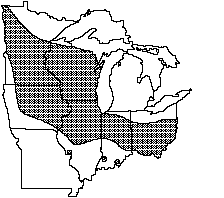Lasmigona compressa (Lea, 1829)

Other common names: None.
Key characters: Relatively thin, elongate shell, well-developed lateral teeth, prominent flattened posterior ridge, double-looped beak sculpture.
Similar species: Fluted-shell, white heelsplitter
Description: Shell small to medium-sized, elongate, relatively thin, and compressed. Anterior end broadly rounded, posterior end bluntly pointed and squared at the tip. Posterior ridge prominent and broadly flattened with a small wing behind the umbo, usually more evident in small shells. Dorsal margin straight, ventral margin rounded, occasionally straight. Umbos projecting slightly above the hinge line. Beak sculpture of five to eight double-looped ridges. Shell smooth and yellowish brown with numerous green rays in young individuals, becoming darker green or brown in older shells. Length to 4 inches (10.2 cm).

Pseudocardinal teeth well developed; two in the left valve, one in the right. Lateral teeth short, thin, and finely serrated; two in the left valve, one in the right. Beak cavity very shallow. Nacre white to salmon-colored, especially near the beak cavities.
Habitat: Creeks and the headwaters of small to medium rivers in fine gravel or sand. Rarely found in larger rivers.
Status: Widespread but uncommon. Threatened in Illinois and Iowa.

